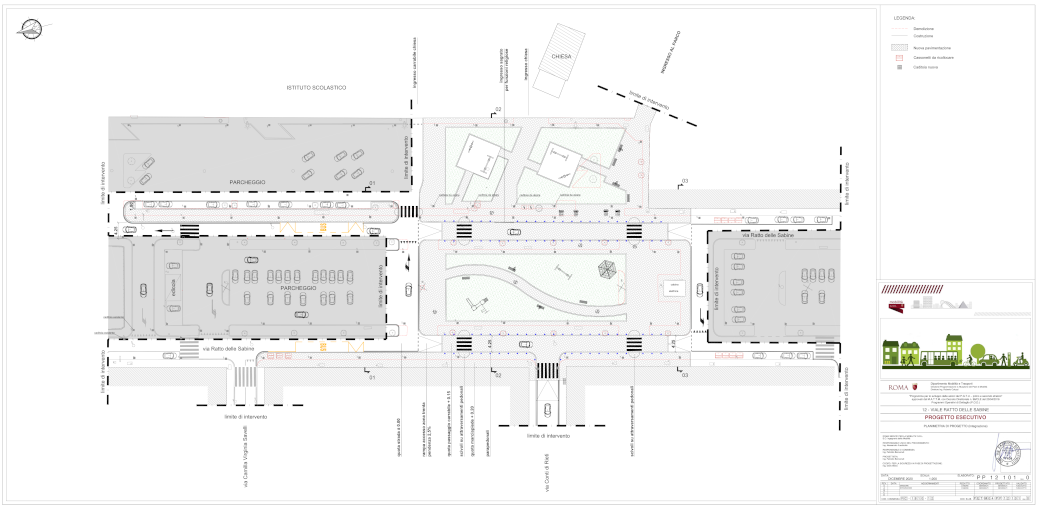
That of Casal Monastero - to quote what is written on the website of one of the most active neighborhood committees in the area - "is the story of a neighborhood born close to the Grande Raccordo Anulare and, perhaps because of this, condemned in the bud to live with it, in a relationship of obligatory symbiosis with the road, with asphalt, with the automobile."
Viale Ratto delle Sabine is the heart of the neighborhood, the main axis along which the most important local functions reside: commerce, social and community activities, religious center and schools. However, the avenue is still conceived as a major thoroughfare through the neighborhood, more car-friendly and less for pedestrians, especially elderly people or children. The size and geometry of the avenue do not provide spaces for people in the neighborhood to share and give the idea of (old) car-centric oversizing.
The redevelopment project that Rome Mobility Services is about to implement aims precisely to remedy the initial distortions through a series of interventions aimed at:
- reduce the speed of vehicles traveling along Viale Ratto delle Sabine
- create a large pedestrian space, a new large square in the central space of the avenue, usable safely also and especially by weak users
- redevelop urban spaces
- create a point of sociality and aggregation for citizenship
- place bicycle racks, to also encourage more sustainable modes of local travel
- secure pedestrian paths and crossings, to and from schools, to and from the parish church of St. Henry
- break down all architectural barriers.
All this will be possible through the pedestrianization of a part of Viale Ratto delle Sabine, with the transformation of part of the parking lot in front of the parish of Sant'Enrico into a green zone and the creation of a Zone 30 obtained by raising the roadway to the same height as the sidewalk and the new pedestrian zone.
Specifically, a green area with children's games will be created in the latter; it will be crossed by a pedestrian path lined with benches, and a kiosk will be placed in the center of the area.
The space in front of the parish church will be completed with pedestrian pathways to serve the two amenity areas and the parish itself.
In addition to the raised crossing, in approach to the pedestrian area the existing sidewalks will be widened to achieve a narrowing of the section of the two carriageways of Viale Ratto delle Sabine, and thus oblige passing cars to reduce the speed of crossing Zone 30 as much as possible, equalizing it to walking pace.
The new paving will also induce speed reduction, and the two pairs of existing crosswalks on the avenue will be raised with the installation of characteristic paving to better highlight the pedestrian transit zone.
The paths and pedestrian spaces will still be protected by bollards along their entire length.
The intervention will be completed with the placement of some bike racks to witness the change of vocation of the area and aimed at encouraging the use of alternative modes, at least for local travel.
The organization of the construction site includes, in chronological order:
- the construction of the central island
- the raising of the roadway to sidewalk level
- the construction of the new pavement
- the widening of the sidewalks.
The space in front of the parish church will be completed with pedestrian paths to serve the two equipped areas and the parish itself.
In addition to the raised walkway, in approach to the pedestrian area the existing sidewalks will be widened to achieve a narrowing of the section of the two carriageways of Viale Ratto delle Sabine, and thus oblige passing cars to reduce the speed of crossing Zone 30 to the maximum, equalizing it to a walking pace.
The new paving will also induce speed reduction, and the two pairs of existing crosswalks on the avenue will be raised with the installation of a paving feature to better highlight the pedestrian transit zone.
The paths and pedestrian spaces will still be protected by bollards along their entire length.
The intervention will be completed with the placement of some bike racks to witness the change of vocation of the area and aimed at encouraging the use of alternative modes, at least for local travel.
The organization of the construction site includes, in chronological order:
- the construction of the central island
- the raising of the roadway to sidewalk level
- the construction of the new pavement
- the widening of the sidewalks

